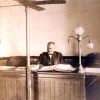calsfoundation@cals.org
Fayette Melton (Execution of)
Fayette (or Lafayette) Melton was a Ku Klux Klan (KKK) leader hanged at Corning (Clay County) on January 30, 1885, for a murder he denied committing.
Franklin Hale of Clay County was “shot through the heart on his own door-step” on May 10, 1881, and Fayette Melton was arrested for the crime but freed after Henry Lawrence and William Rich provided him with an alibi. Three years later, however, Lawrence approached authorities and provided a sworn statement that Melton and Rich had murdered Hale. The two were indicted, and Rich “fled the country” while Melton went to trial.
Lawrence was the first witness in the August 1884 trial, and he testified that Melton was “captain” of a Ku Klux Klan band in which he and Rich were both members. He said that Hale had made disparaging remarks about the band, so “we masked ourselves, went to his home, took him out and gave him a good flogging.” He said that they later decided to kill Hale and that Melton and Rich went to do it but failed initially “because it was so dark.” Melton told him that he had later killed Hale, Lawrence claimed.
Melton was convicted and then appealed to the Arkansas Supreme Court, which upheld the verdict on December 31, 1884. An Arkansas Gazette reporter, who described Melton as “a good-looking young fellow of about 28 years, brown hair and a heavy blonde mustache,” interviewed him in the state penitentiary. Melton admitted to being the captain of the “Southern Brotherhood,” a Clay County branch of the Ku Klux Klan that aimed to “suppress lawlessness, punish those whom we thought deserved it, and keep order in the county.”
Melton claimed that Hale was “a bad man” who had beaten his wife “most awfully,” so the Klansmen took him from his home, tied him to a tree, and whipped him. Hale recognized several of his attackers and vowed revenge. Melton said that “he was a quick hand with a gun and there was no telling when he might lay some of us out,” so they decided to kill him, but he and Rich failed to do so, and “that’s all I knew of the matter until I heard he was killed.”
Governor James H. Berry set January 30, 1885, as the date for Hale to hang. He was taken to the Clay County Courthouse where “he was allowed to have visitor[s] and the courtroom was filled until noon, when he was served his last meal.” Different accounts say that between 500 and 2,000 people gathered to watch the execution. Melton left the courthouse at 1:00 p.m. for the “march to the scaffold in the goose pasture.”
A St. Louis newspaper wrote that “the doomed man met his death bravely, preserving a firm demeanor on the scaffold, and asserted his innocence to the last” while an account in an Ohio paper said Melton “evinced no emotion as he mounted the scaffold, but broke down sobbing while being tied.” His last words to the crowd were: “Good-bye, all. Boys, let this be a warning to you to keep good company.”
His neck was broken when he fell through the trap door, and he was declared dead at 1:35 p.m. Melton was buried next to murderer Luther Taylor, who had been hanged three years earlier, outside the gates of the Corning cemetery.
For additional information:
“Captain of the Kuklux.” Arkansas Gazette, January 2, 1885, p. 8.
“Ku-Kluxer Hanged.” Cincinnati Post, January 30, 1885, p. 1.
“Miscellaneous Items.” Southern Standard, January 10, 1885, p. 1.
“Murderer Hanged.” Memphis Daily Appeal, January 31, 1885, p. 2.
“A Public Exhibition.” St. Louis Post-Dispatch, January 30, 1885, p. 2.
“Two More.” Arkansas Gazette, January 1, 1885, p. 4.
“Washington Lafayette Melton.” Find a Grave. https://www.findagrave.com/memorial/114445777/lafayette-melton (accessed August 2, 2025).
Mark K. Christ
Little Rock, Arkansas
 Law
Law Post-Reconstruction through the Gilded Age, 1875 through 1900
Post-Reconstruction through the Gilded Age, 1875 through 1900 Melton Execution Article
Melton Execution Article 



Comments
No comments on this entry yet.